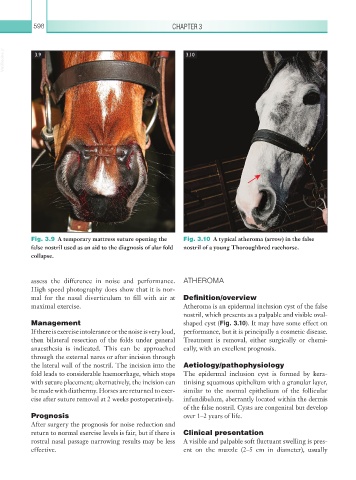Page 623 - Equine Clinical Medicine, Surgery and Reproduction, 2nd Edition
P. 623
598 CHAPTER 3
VetBooks.ir 3.9 3.10
Fig. 3.9 A temporary mattress suture opening the Fig. 3.10 A typical atheroma (arrow) in the false
false nostril used as an aid to the diagnosis of alar fold nostril of a young Thoroughbred racehorse.
collapse.
assess the difference in noise and performance. ATHEROMA
High speed photography does show that it is nor-
mal for the nasal diverticulum to fill with air at Definition/overview
maximal exercise. Atheroma is an epidermal inclusion cyst of the false
nostril, which presents as a palpable and visible oval-
Management shaped cyst (Fig. 3.10). It may have some effect on
If there is exercise intolerance or the noise is very loud, performance, but it is principally a cosmetic disease.
then bilateral resection of the folds under general Treatment is removal, either surgically or chemi-
anaesthesia is indicated. This can be approached cally, with an excellent prognosis.
through the external nares or after incision through
the lateral wall of the nostril. The incision into the Aetiology/pathophysiology
fold leads to considerable haemorrhage, which stops The epidermal inclusion cyst is formed by kera-
with suture placement; alternatively, the incision can tinising squamous epithelium with a granular layer,
be made with diathermy. Horses are returned to exer- similar to the normal epithelium of the follicular
cise after suture removal at 2 weeks postoperatively. infundibulum, aberrantly located within the dermis
of the false nostril. Cysts are congenital but develop
Prognosis over 1–2 years of life.
After surgery the prognosis for noise reduction and
return to normal exercise levels is fair, but if there is Clinical presentation
rostral nasal passage narrowing results may be less A visible and palpable soft fluctuant swelling is pres-
effective. ent on the muzzle (2–5 cm in diameter), usually

